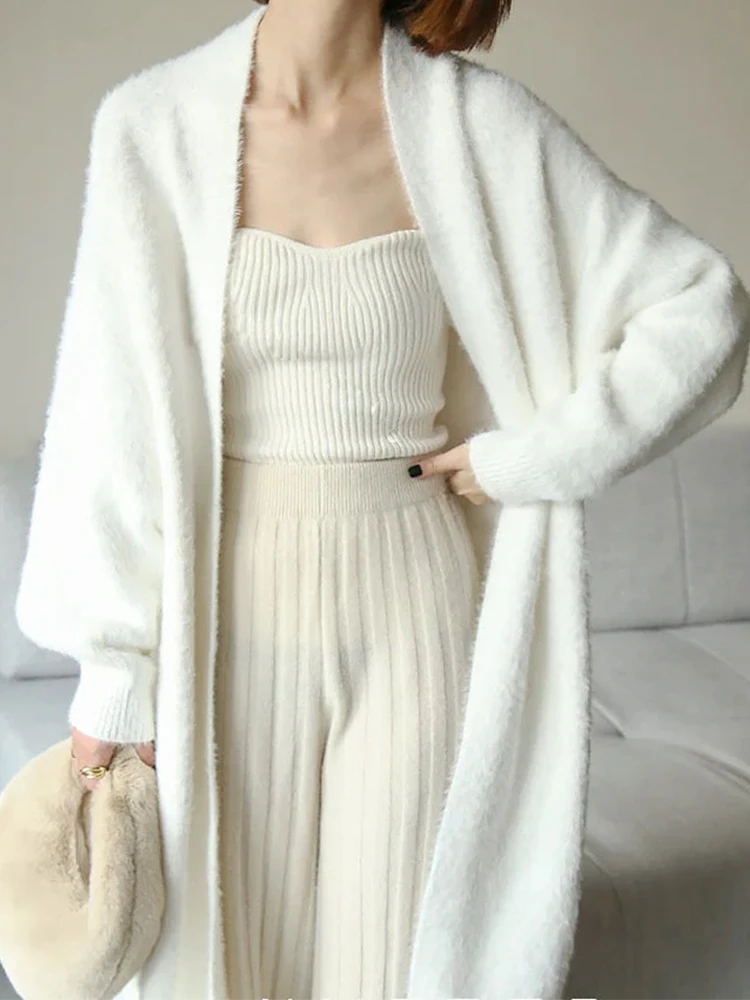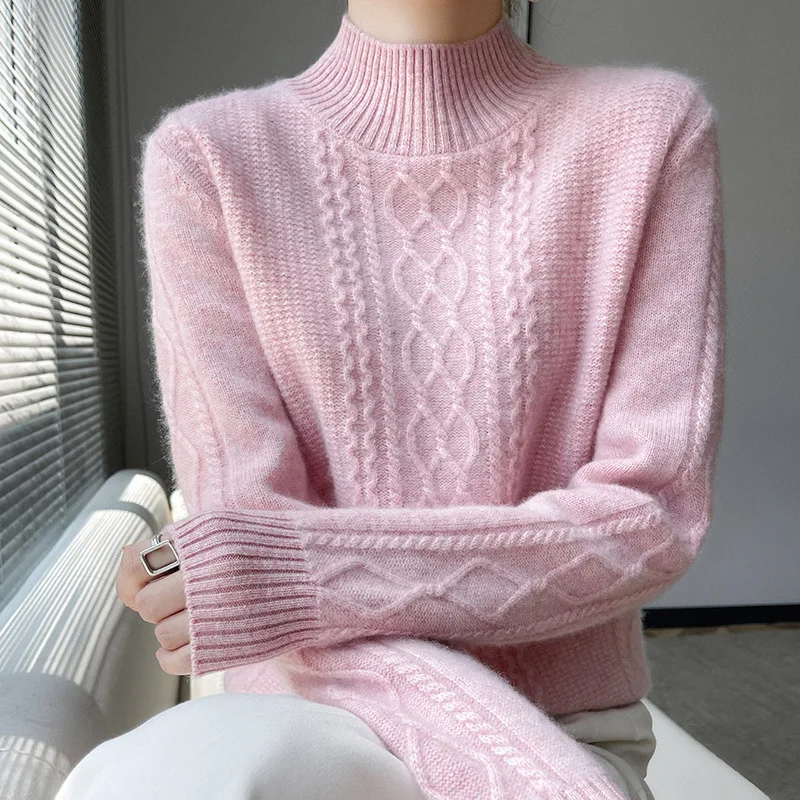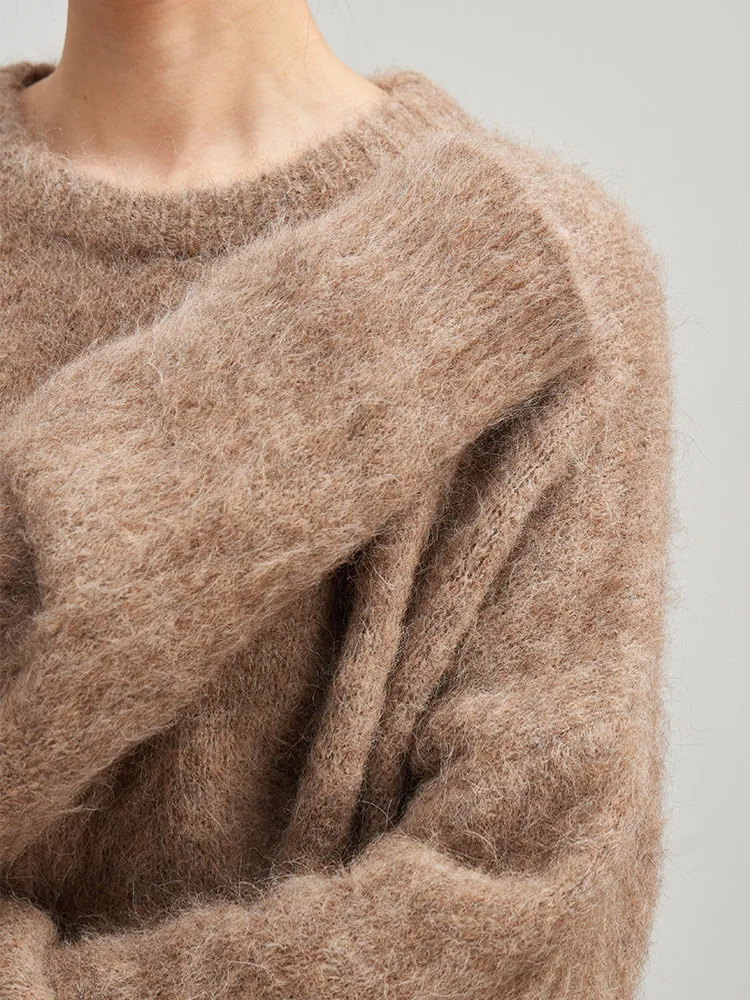Introduction to Cashmere Longevity
Premium cashmere represents more than just a clothing purchase—it’s an investment in luxury, comfort, and timeless style. When you acquire a high-quality cashmere piece from Estate Cloth, you’re not just buying a garment; you’re investing in something that can provide warmth and elegance for decades with the right care approach.
What many cashmere owners don’t realize is that proper care doesn’t just maintain your garment—it actively preserves and extends its life. Quality Grade A cashmere with fibers under 16 microns thickness responds remarkably well to consistent care routines, rewarding your attention with enhanced softness and resilience year after year.
The difference between basic maintenance and true preservation is significant:
– Well-preserved cashmere can maintain its luxurious feel for 20+ years
– Properly cared-for pieces can outlast lower quality items by 3-4 times
– Premium cashmere actually becomes softer with proper care over time
This comprehensive guide will walk you through everything from daily wearing habits to seasonal storage techniques, ensuring your investment remains pristine through years of enjoyment. Think of proper cashmere care as protecting not just the garment, but the exceptional experience it delivers with every wear.
Understanding the foundational knowledge about cashmere care creates the perfect foundation for maintaining your luxury pieces for years to come.
Understanding Cashmere Fiber Properties
To properly care for cashmere, you need to understand what makes it special. Grade A cashmere—the gold standard used in all Estate Cloth garments—features fibers under 16 microns in thickness and exceeding 36mm in length. These aren’t just numbers; they’re indicators of exceptional quality that directly affect how your garment performs and how it should be treated.
What makes cashmere truly remarkable is its microscopic structure:
– Hollow fibers that trap warm air while remaining lightweight
– Natural crimp that creates insulating pockets without bulk
– Exceptional tensile strength when undisturbed
– Natural elasticity that allows fibers to return to shape
These properties explain why cashmere provides three times more insulation than regular wool while weighing significantly less. The hollow fiber structure creates remarkable warmth without weight—but it also means cashmere requires gentler handling than most other materials.
Common damage occurs through:
– Felting (when fibers lock together from agitation)
– Stretching (when wet fibers are pulled beyond their natural elasticity)
– Fiber breakage (from harsh chemicals or rough handling)
– Pilling (when shorter fibers work their way to the surface)
Understanding these vulnerabilities is crucial because damage to cashmere isn’t always immediately visible. Often, the effects of improper care appear gradually as decreased softness, diminished warmth, or progressive shape distortion.
The specialized properties of cashmere fibers explain why judging cashmere quality by touch is both an art and science—and why proper care techniques must be tailored specifically to this extraordinary material.
Daily Wear Habits for Maximum Longevity
The way you wear your cashmere significantly impacts its lifespan. Implementing these practices will protect your garments during active use:
Implement a rotation system: Allow cashmere to rest 24-48 hours between wearings. This recovery period lets the fibers relax back to their natural shape and release moisture absorbed during wear.
Minimize friction points: Be conscious of where your cashmere contacts other surfaces. Avoid shoulder bags that rub against the same spot repeatedly, remove jewelry with rough edges before wearing, and be mindful of desk or counter edges that might cause friction.
Layer strategically: Wear a light cotton layer beneath cashmere when possible, especially in high-friction areas. This reduces direct skin contact and protects the garment from body oils and deodorant residue.
Address spills immediately: Blot (never rub) any liquid spills gently with a clean, absorbent cloth. For spot cleaning on the go, sparkling water can help lift minor stains without setting them deeper into fibers.
End-of-day care ritual: Give cashmere items a gentle shake after wearing, then let them air for 30 minutes before storing. This simple habit prevents odor accumulation and helps fibers recover.
Apply personal products thoughtfully: Always apply perfume, hairspray, and body products before putting on cashmere, allowing them to dry completely.
Be mindful of environment: Protect cashmere from rough surfaces, pet claws, and cooking splatter—seemingly minor encounters that can damage delicate fibers.
These daily habits form the foundation of long-term cashmere preservation and complement the styling versatility of various cashmere cardigan styles that make these garments wardrobe essentials.
Essential Folding and Storage Techniques
Proper storage begins the moment you remove your cashmere. The cardinal rule is simple but non-negotiable: always fold, never hang. Hanging creates shoulder distortion as gravity pulls on the fibers, potentially causing permanent stretching.
Perfect Folding Technique:
– Lay the garment face-down on a clean, flat surface
– Fold arms back, crossing them if necessary
– Fold sides inward about one-third each
– Fold bottom up once or twice depending on garment length
– Store with folded side visible for easy identification
For drawer organization, avoid overcrowding—cashmere needs to breathe and maintain its shape without compression. Consider using acid-free tissue paper between folded garments to prevent friction and transfer of oils between pieces.
Short-term storage during wearing season should prioritize:
– Clean, dry drawers or shelves
– Protection from direct sunlight (which can fade colors)
– Distance from heat sources that might dry fibers
– Breathable containers rather than airtight options
– Cedar elements to deter moths (placed near but not directly on garments)
The ideal storage environment maintains moderate humidity (around 50%) and consistent temperature (around 65-70°F/18-21°C). These conditions prevent the fibers from drying out or being exposed to excess moisture that could encourage mildew growth.
For more detailed guidance on maintaining your luxury pieces during non-wearing periods, explore our comprehensive preserving luxury cashmere storage tips which expand on these fundamental practices.
Deep Cleaning Methods: Hand Washing Excellence
Knowing when to wash cashmere is as important as knowing how. Overwashing accelerates wear, while underwashing allows oils and dirt to weaken fibers. Generally, wash after 2-3 wears or once per season for lightly worn items.
Pre-Washing Assessment:
– Check for stains requiring special treatment
– Examine for loose threads or damage needing repair before washing
– Review garment for any “dry clean only” indicators
Hand Washing Step-by-Step:
- Fill a clean basin with cold to lukewarm water (never above 85°F/29°C)
- Add a small amount of cashmere-specific detergent or gentle, lanolin-free shampoo
- Turn garment inside out and submerge fully
- Gently press water through the garment without wringing or twisting
- Soak for 10-15 minutes, occasionally pressing (not agitating)
- Drain soapy water and refill basin with clean, cool water
- Rinse by gently pressing water through garment
- Repeat rinse process 2-3 times until all soap is removed
Critical Considerations:
– Never use fabric softener (it coats fibers and reduces breathability)
– Avoid enzymatic detergents which can attack protein fibers
– Test water temperature on your wrist—if it feels warm, it’s too hot for cashmere
– Complete the entire process without interruption
Investing in proper cleaning techniques ensures that your premium cashmere sweaters maintain their exceptional quality and luxurious feel throughout years of wear.
Drying Techniques for Perfect Shape Retention
The drying phase is where many cashmere care mistakes occur, yet it’s critical for maintaining your garment’s shape and texture. Proper drying begins immediately after washing.
Start by gently pressing excess water from your garment—never wring, twist, or squeeze aggressively. Place the cashmere flat between two clean, dry white towels and press gently to absorb moisture. Replace with fresh towels if needed.
For the main drying phase:
– Lay the garment flat on a clean, dry white towel
– Reshape carefully to original dimensions while damp
– Keep away from direct heat sources and sunlight
– Ensure air can circulate around the garment
– Flip occasionally for even drying (every few hours)
– Expect 24-48 hours for complete drying
Pay special attention to collar, cuffs, and hem areas, gently reshaping them to their original form. If sleeves appear stretched, gently push them inward to restore proper dimensions. For ribbed sections, lightly squeeze them back to their natural elasticity.
Warning signs of improper drying include:
– Stiffness in normally fluid areas
– Uneven texture across the garment
– Stretched or distorted sections
– Loss of natural elasticity
The patience invested in proper drying techniques directly impacts how women’s cashmere pullovers and other styles maintain their luxurious drape and perfect fit through seasons of wear.

Pilling Management: Prevention and Removal
Pilling—those small fuzzy balls that appear on cashmere surfaces—is natural but manageable. Even the highest quality cashmere will pill to some degree, especially in high-friction areas like underarms and sides.
Prevention Strategies:
– Limit friction against rough surfaces
– Reduce rubbing between fabric sections
– Hand wash rather than machine wash
– Turn garments inside out during washing
– Allow proper rest between wearings
Effective Removal Techniques:
For light, surface pilling:
1. Lay garment on flat, hard surface
2. Use a cashmere comb with gentle, directional strokes
3. Work in one direction only, never back and forth
4. Keep strokes light and consistent
For more established pills:
1. Use a battery-operated fabric shaver designed for delicates
2. Hold fabric taut but not stretched
3. Pass the device lightly over the surface
4. Remove collected pills frequently from the device
The ideal frequency for de-pilling is after you notice initial formation but before pills become pronounced. Typically, addressing pills once per season is sufficient for moderately worn items.
Quality cashmere with longer fibers (like those exceeding 36mm in Estate Cloth garments) will pill less over time as shorter, weaker fibers work their way out through normal wear. This means pilling often decreases with proper care and regular gentle removal.
These maintenance practices ensure your stylish cashmere cardigans maintain their elegant appearance through years of regular wear.
Seasonal Storage: The Comprehensive Protection Plan
When transitioning your cashmere to seasonal storage, preparation is essential. This comprehensive approach ensures your garments emerge from storage in the same pristine condition they entered.
Pre-Storage Checklist:
– Clean all items thoroughly—never store soiled cashmere
– Ensure garments are completely dry (at least 48 hours after washing)
– Address any pills, snags, or repairs needed
– Make sure storage containers are clean and dust-free
Optimal Storage Environment:
– Temperature: 60-70°F (15-21°C)
– Humidity: 40-50% (not too dry, not too damp)
– Air circulation: Some is beneficial
– Light exposure: Minimal to none
– Elevation: Not directly on concrete floors
Container Considerations:
– Natural fiber storage bags (cotton or linen) are ideal
– Acid-free tissue paper for layering between folds
– Cedar elements nearby but not in direct contact
– Avoid completely airtight containers which prevent breathing
Natural Moth Deterrents:
– Cedar blocks/rings (refresh by sanding every 3-4 months)
– Lavender sachets (replace every 2-3 months)
– Rosemary and clove pouches (alternate with lavender)
Establish a mid-storage inspection routine approximately halfway through the off-season. Gently refold garments in a different pattern to avoid permanent crease lines, refresh natural repellents, and check for any signs of pests.
These specialized storage techniques are particularly important for preserving the distinctive shape of cashmere turtlenecks and other architectural styles that require careful structure maintenance.
Moth and Pest Prevention: Critical Protection Strategies
Moths and other pests are attracted to protein fibers like cashmere, making proactive prevention essential. The biggest mistake most people make is waiting until they spot moths before taking action—by then, damage is often already done.
Early Warning Signs:
– Small holes, especially in clusters
– Silky tubes or casings in folds
– Fine, sand-like particles near garments
– Fluttering moths in storage areas
Create a multi-layered defense system:
1. Regular cleaning removes food sources (skin cells, food particles)
2. Cedar elements emit oils that repel moths
3. Herbal deterrents provide secondary protection
4. Periodic inspection catches problems early
5. Proper ventilation prevents humid conditions moths prefer
For maximum protection, consider implementing a rotation of different natural repellents. Moths can become accustomed to a single scent, so alternating between cedar, lavender, and herb mixtures provides more comprehensive protection.
The emergency freezing method for suspected infestations:
– Seal the garment in an airtight plastic bag
– Place in freezer at 0°F (-18°C) or colder for at least 72 hours
– Remove, let reach room temperature, then shake gently outdoors
– Repeat the freeze cycle once more for complete elimination
Remember that moth prevention is ongoing—cedar needs refreshing every 3-6 months by light sanding to release oils, and herbal sachets require replacement as their scent fades. This consistent attention ensures your cherished pieces remain protected between occasions when you’re layering tips with cashmere cardigans for everyday elegance.
Addressing Snags, Pulls and Minor Damage
When you spot a snag or pull in your cashmere, immediate gentle intervention can prevent further unraveling. The key is addressing issues while they’re still minor.
For Simple Snags:
1. Never cut a pulled thread
2. Turn the garment inside out
3. Use a fine crochet hook (1mm or smaller)
4. Gently pull the snagged thread to the inside
5. Distribute tension across surrounding stitches
For More Significant Pulls:
1. Identify where the thread should be in the knit pattern
2. Use a blunt tapestry needle to reposition the thread
3. Gently work the fiber back into alignment with surrounding stitches
4. Secure with a tiny drop of fabric stabilizer if needed
Assess damage severity using this framework:
– Minor: Single thread pulled but intact (self-repair appropriate)
– Moderate: Multiple threads affected but no actual hole (self-repair possible)
– Severe: True hole or extensive unraveling (professional repair recommended)
Prevention strategies include:
– Being mindful of jewelry with rough edges
– Using protective garment bags when traveling
– Checking furniture for rough spots that might snag
– Taking extra care when wearing with brooches or pins
For valuable or extensively damaged pieces, professional repair is worth considering. The specialized construction of brushed cashmere sweaters requires particular attention, as their raised surface can make damage assessment more challenging.

Restoring Softness and Shape to Aged Cashmere
Even well-maintained cashmere can gradually lose some of its renowned softness or develop slight shape changes. Recognizing when your garment needs restoration is the first step toward revitalizing it.
Signs Your Cashmere Needs Restoration:
– Diminished softness despite regular cleaning
– Slight stiffness in normally fluid areas
– Compressed or flattened appearance
– Minor shape distortion in cuffs or hem
Gentle Reconditioning Process:
1. Hand wash using the technique described earlier
2. For the final rinse, add 1 tablespoon of white distilled vinegar per gallon (3.8 liters) of water
3. Soak for 5 minutes, then rinse thoroughly with clean water
4. Press excess water out gently between towels
5. Reshape more assertively during drying, gently stretching compressed areas
For Severe Compression or Flattening:
1. While the garment is damp (not wet), gently steam from 6 inches away
2. Use fingertips to lightly lift and separate flattened fibers
3. Allow to dry completely away from heat
4. Finish with very gentle brushing using a cashmere brush
Cashmere-specific hair conditioner treatments can also help restore softness:
– Select a silicone-free, lanolin-based conditioner
– Dilute 1 teaspoon in a basin of cool water
– Soak clean garment for 10 minutes
– Rinse thoroughly and dry as directed earlier
These restoration techniques are particularly effective for long cashmere cardigans that may develop shape inconsistencies due to their greater fabric weight and drape.
Cashmere Wrap Sweaters, Women's Cashmere Pullovers
$75.89 Select options This product has multiple variants. The options may be chosen on the product pageCashmere Cable Knit Sweaters, Women's Cashmere Pullovers
Price range: $111.82 through $112.93 Select options This product has multiple variants. The options may be chosen on the product pageCropped Cashmere Sweaters, Women's Cashmere Pullovers
$155.77 Select options This product has multiple variants. The options may be chosen on the product pageOversized Cashmere Sweaters, Plus Size Cashmere Sweaters, Women's V-Neck Cashmere Sweaters
$136.87 Select options This product has multiple variants. The options may be chosen on the product page- Price range: $108.11 through $130.03 Select options This product has multiple variants. The options may be chosen on the product page
Striped Cashmere Sweaters, Women's Cashmere Pullovers
$139.68 Select options This product has multiple variants. The options may be chosen on the product page
Advanced Stain Treatment Guide
Time is critical when addressing stains on cashmere. Always blot—never rub—and treat stains before they set. This guide offers targeted approaches based on stain type.
Oil and Grease Stains:
1. Apply absorbent powder (cornstarch, talcum powder) immediately
2. Let sit for 30 minutes to absorb oil
3. Brush away powder gently
4. If stain persists, use a tiny amount of diluted mild dish soap
5. Blot with clean water and air dry
Wine, Coffee, and Tea:
1. Blot immediately with absorbent cloth
2. Apply cold water by blotting (never rubbing)
3. For stubborn stains, use diluted white vinegar (1 part vinegar to 2 parts water)
4. Rinse thoroughly by blotting with clean water
5. Air dry away from heat
Cosmetic Stains:
1. For lipstick, gently scrape excess with dull edge
2. Apply small amount of oil-free makeup remover to a cloth
3. Blot stain gently, working from outside inward
4. Rinse with cool water by blotting
5. Wash according to regular instructions if needed
Ink and Dye:
1. Blot immediately without spreading
2. Apply small amount of alcohol-free hairspray to a cloth
3. Dab gently at stain
4. Rinse thoroughly by blotting
5. For persistent stains, seek professional help
Protein-Based Stains (food, blood):
1. Rinse immediately with cold water (never warm/hot)
2. Apply diluted enzymatic stain remover designed for protein fibers
3. Let sit for 30 minutes maximum
4. Rinse thoroughly with cool water
5. Proceed with normal washing if needed
For any stain that doesn’t respond to gentle treatment, or for valuable items, professional cleaning is recommended rather than aggressive home treatment that might damage fibers. Understanding proper treatment methods helps maintain the pristine appearance necessary when preserving luxury cashmere fabric for years of enjoyment.

When to Seek Professional Services
While home care is sufficient for most cashmere maintenance, certain situations warrant professional intervention. Recognizing these scenarios can save a treasured garment from permanent damage.
Situations Requiring Professional Care:
– Large or set-in stains that home treatments haven’t resolved
– Significant holes or structural damage
– Color restoration for faded garments
– Extensive pilling that affects garment integrity
– Major reshaping needs after improper storage
– Heritage pieces requiring conservation
When selecting a professional cashmere care provider, look for:
– Specific experience with luxury knits
– Hand-cleaning options rather than standard dry cleaning
– Understanding of blocking and reshaping techniques
– Willingness to discuss their specific processes
– Recommendations from luxury retailers or other customers
Questions to ask potential service providers:
– “What cleaning agents do you use specifically for cashmere?”
– “How do you handle reshaping after cleaning?”
– “Do you offer repair services for minor damage?”
– “What precautions do you take to protect buttons and trim?”
Document your garment’s condition before service with clear photos from multiple angles. For valuable pieces, request written details about the intended cleaning and restoration process before proceeding.
Professional services typically cost between $20-50 per item depending on the service required, making it a worthwhile investment for preserving high-value cashmere pieces.
Essential Cashmere Care Toolkit Assembly
Building a complete cashmere care kit ensures you’re prepared for routine maintenance and unexpected situations. These tools represent a small investment compared to the value of the garments they’ll help preserve.
Cleaning and Washing Essentials:
– Cashmere-specific wash (pH-balanced, lanolin-free)
– Large basin for hand washing
– Absorbent white towels (free of fabric softener)
– Stain treatment kit with appropriate solutions
– Measuring spoons for precise detergent amounts
Surface Maintenance Tools:
– Cashmere comb (fine-toothed, specifically for knits)
– Battery-operated fabric shaver (with adjustable height)
– Lint roller with gentle adhesive
– Soft-bristled clothes brush for surface dust
– Natural bristle brush for general maintenance
Storage and Protection:
– Cotton storage bags (breathable, acid-free)
– Cedar blocks or rings with refreshing sandpaper
– Lavender sachets or other natural repellents
– Acid-free tissue paper for folding
– Moisture-absorbing silica packets for humid environments
Repair and Restoration:
– Fine crochet hooks (sizes 0.6mm-1.0mm)
– Blunt tapestry needles
– Small scissors with precise tips
– Thread in colors matching your cashmere pieces
– White vinegar for softness restoration
Tools to Avoid:
– Standard lint removers with aggressive adhesive
– Harsh bristle brushes that can damage fibers
– Typical laundry detergents with enzymes or brighteners
– Standard fabric softeners in any form
– Steam irons applied directly to the fabric
Store your cashmere care supplies together in a clean, dry container, keeping them accessible during wearing season and checking them annually to replace or refresh as needed.
The Environmental Impact of Extended Cashmere Care
The environmental benefits of extending your cashmere’s lifespan go far beyond your wardrobe. By implementing proper care techniques, you’re participating in a more sustainable approach to luxury.
When you double or triple a cashmere garment’s useful life through proper care:
– You reduce demand for new raw materials
– You minimize the water, energy, and chemicals used in production
– You decrease textile waste in landfills
– You lower your fashion carbon footprint
– You practice slow fashion principles in the most effective way
The numbers tell a compelling story:
– A well-maintained cashmere garment can last 20+ years versus 3-5 years with poor care
– Extending garment life by just nine months reduces its environmental impact by 20-30%
– The resources required for proper maintenance are minimal compared to those needed for new production
Quality cashmere represents the opposite of disposable fashion. Its ability to last for decades makes it inherently more sustainable than cheaper alternatives that require frequent replacement. Through dedicated care, you transform a luxury purchase into a genuinely sustainable choice.
By investing time in proper cashmere maintenance, you’re not just preserving a garment—you’re participating in a more mindful approach to consumption that values longevity over replacement.







